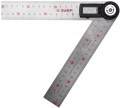Length
Working length of the tool. The meaning of this parameter may be different, depending on the type (see above) and design features. So, for bubble levels, rules and inclinometers, the total length is indicated, while in sliding models (see "Functions") data are given for the maximum length, unfolded. For goniometers, on the contrary, the length is indicated by the size of the main bar, that is, in the folded state; and for hydraulic levels, a slightly different parameter is used — the length of the hose, it is given separately (see below).
In general, the longer the tool — the larger the surface it can measure or (in the case of rules) process, the more advanced and professional this model is considered. On the other hand, a longer fixture will also be more expensive and cumbersome, and in cramped conditions, problems may arise up to the complete impossibility of use. Therefore, when choosing, you need to take into account the specifics of the work and the scale of the proposed measurements. For example, for ordinary home repairs, a level of 40 – 50 cm is quite enough, for the construction of a small extension, you should choose a larger model, by 70 – 80 centimeters, and the length of high-quality bubble levels
can exceed 3 m. At the same time, very small instruments of this type are also produced — from 7 cm. Such
pocket levels can be useful, for example, for calibrating a geodetic instrument that
...does not have its own alignment tools. And you can carry it in your pocket, bag, tool box. But the rules, by definition, are made long — from 1 m.Width
Tool width. In fact, the width of the rib corresponds to the width of the front panel — that is, the main operating panel, from which the "vertical" and "oblique" capsules are visible, on which the
digital display is located, etc.
The large width adds strength to the tool and reduces the chance of deformation, but makes it difficult to use in narrow spaces: for example, a mirror capsule may be required to control the vertical in a narrow gap (see "Functions"). Note that long tools are inevitably made wide — otherwise it would be impossible to provide the necessary strength.
Thickness
Tool size in thickness, from front to back. In fact, this is the smallest slit in which this fixture can be placed during measurements (although some measurements may require a mirror capsule, see "Functions"). Therefore, for work in cramped conditions, it is worth using thinner models. At the same time, note that long and heavy tools are inevitably made quite thick — to ensure strength and resistance to deformation.
Accuracy
The accuracy of angle measurements provided by the tool, or rather, the maximum error in degrees that can occur during measurements. This parameter is given for devices originally intended for measuring angles — goniometers and inclinometers (see "Type"). With such measurements, linear accuracy (in millimetres per metre) is not applicable.
The lower the error, the more accurate the instrument will be, the smaller the difference between the actual angle value and the instrument readings can be. On the other hand, high accuracy has a corresponding effect on the price. Therefore, when choosing, you need to take into account the specifics of the work — how important high measurement accuracy is for them.
Power source
The type of power used in the instrument. Classical spirit and water levels operate without power, so this feature is relevant mainly for goniometers and inclinometers (see "Type"), supplemented by various electronics — digital displays, laser pointers, etc. (see "Type").
Usually, replaceable batteries of one size or another are used for power supply, and most often they are not included in the kit. At first glance, this is not very convenient, but this configuration gives the user the opportunity to choose batteries at their discretion by price, quality and type (batteries or rechargeable batteries). Specific options for size can be as follows:
— AA. They are also “finger-type batteries”, a well-known and very popular type of batteries, sold almost everywhere. In levels, however, they are used somewhat less frequently than the more miniature AAA (see below), because. are relatively large.
— AAA. "Little finger batteries", a smaller analogue of the AA described above. Convenient due to relatively compact size; they are inferior to “finger” ones in terms of capacity, however, the built-in electronics of goniometers and inclinometers usually do not have high power consumption, so this drawback can hardly be considered critical.
— PP3. 9 V batteries in rectangular cases; contacts are located on one of the ends. They are used relatively rarely, mainly in professional tools, the hardware of which requires a relatively high supply vol...tage.
— CR2032. Coin batteries with a diameter of 20 mm, a thickness of 3.2 mm and a rated voltage of 3 V. They are mainly used in goniometers and compact inclinometers that do not have high power consumption even by the standards of this type of tool. Note that rechargeable batteries in this size are not produced, however, the batteries are very "long-playing", so this can hardly be called a serious drawback.

